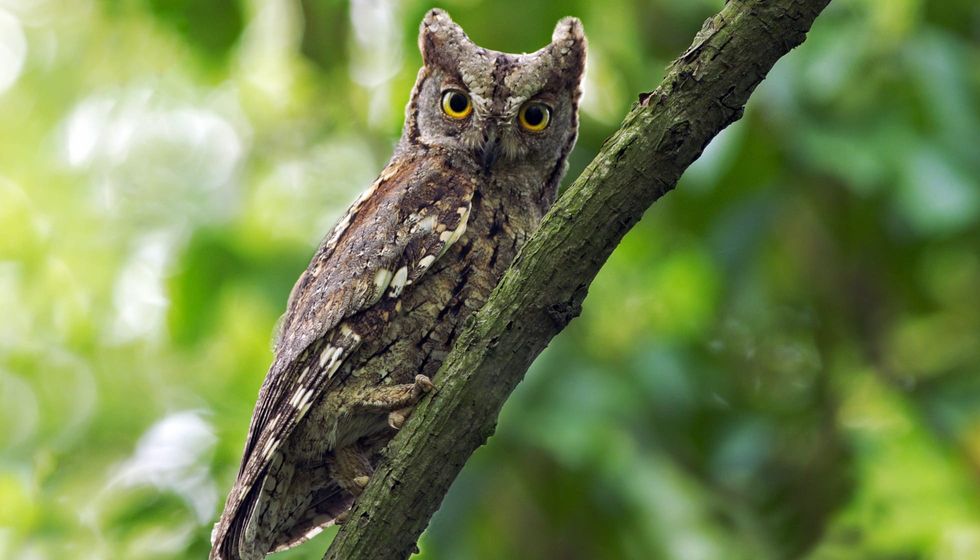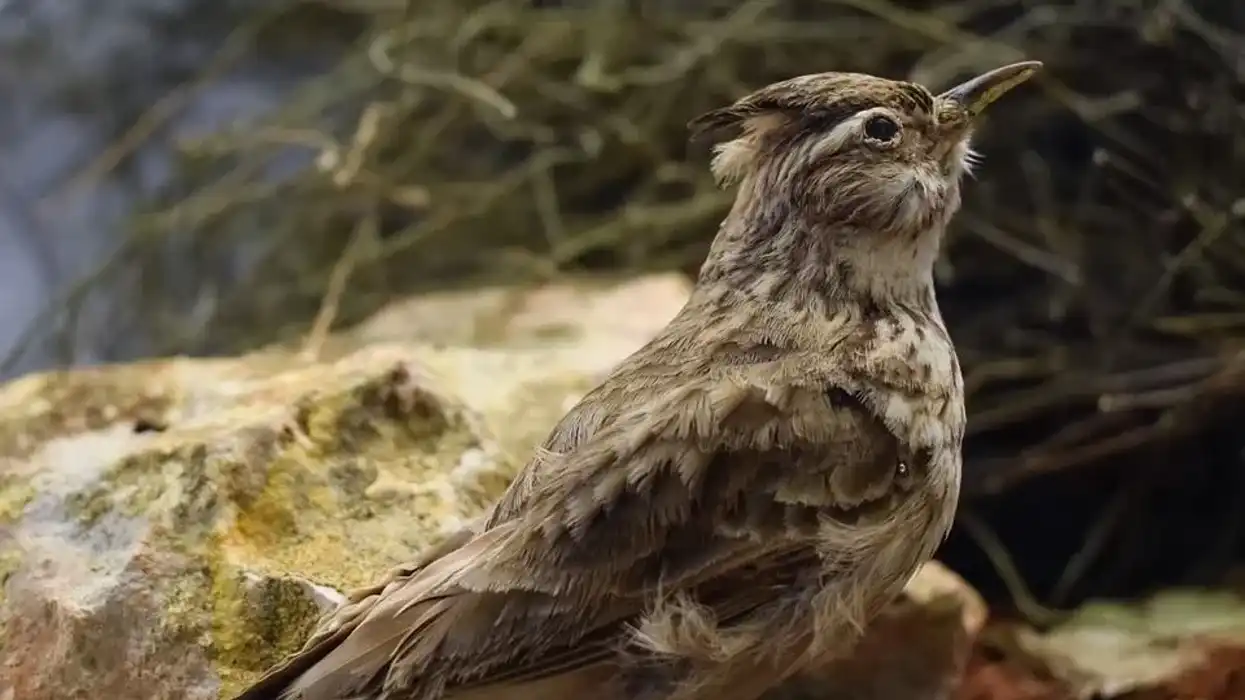The Eurasian scops owl (Otus scops) or simply the scops owl is a species belonging to the family Strigidae, the group comprising true owls or typical owls.
With small ear tufts, golden-yellow eyes, long wings, and a plumage that looks like the bark of an old tree, these nocturnal birds are primarily found in regions of southern Europe, western Asia, and Central Asia and migrate to warmer regions in sub-Saharan Africa during the winter.
Their unique bark-like plumage makes it quite difficult to spot them during the day when the birds roost in tree holes and cavities.
When they are active at night, the bird may be detected by their single hoot calls that tend to get repeated in the form of a dull song.
Owing to their significantly large geographical distribution, the scops owls do not yet feature in the vulnerable or endangered categories of the IUCN Red List. However, even though they have a decent global population size, habitat destruction across their range is causing this bird population to decline rapidly.
These owls are indeed a fascinating species of nocturnal birds. Read on to learn more about them!
If you like what you read, you may also check out interesting facts about the elf owl and red owl!
Eurasian Scops Owl Interesting Facts
What type of animal is a Eurasian scops owl?
The Eurasian scops owl (Otus scops) is a species of true owl belonging to the family Strigidae.
What class of animal does a Eurasian scops owl belong to?
The Eurasian scops owls belong to the class Aves which includes all other birds.
How many Eurasian scops owls are there in the world?
According to a 2019 assessment by the International Union for Conservation of Nature (IUCN) Red List of Threatened Species, there are about 790,000-1,400,000 mature individuals of the Eurasian scops owl present in the world.
Where does a Eurasian scops owl live?
The geographical distribution range of the scops owl primarily includes southern Europe (with local distribution across western, eastern, and central Europe), Asia Minor, Central Asia, and regions north of the Sahara Desert in Africa.
The birds migrate to the savannahs of eastern and western Africa during the winter; they leave their breeding areas in autumn and return during spring or early summer, depending on the breeding location they are retreating to. Some populations have also been recorded breeding in southern Germany.
During the day, the birds normally roost in tree holes, rock cavities, holes in walls, or amidst dense foliage.
What is a Eurasian scops owl's habitat?
Members of the Eurasian scops owl species mostly live in semi-open and open woodlands with scattered trees, riverine forests, rocky landscapes, savannahs with trees, orchards, plantations, parks, roadside trees, and even gardens with old trees. The birds can also be found in Mediterranean scrublands. In warmer climates, the bird can be spotted in mountainous areas.
Who do Eurasian scops owls live with?
The Eurasian scops owls are primarily solitary birds, but pairs ranging between two and seven in number may occasionally be found nesting in loose colonies.
How long does a Eurasian scops owl live?
The lifespan of the Eurasian scops owl is around 10 years, with the maximum age recorded for the bird to be 12 and a half years.
How do they reproduce?
In southern Europe, the breeding season for the resident scops owl population usually spans between March and August. The breeding season of migrating populations begins upon their return from the winter abodes. The species is mostly monogamous, having one mating partner throughout, but may occasionally be polygynous, with one male having multiple female partners.
Mating is preceded by a courtship duet by the male and female partners. The breeding site of the owls may include holes and cavities in trees, buildings or walls, nest boxes, and sometimes nests of other bird species such as the magpie, raptor, or bee-eater.
After mating, the female lays a clutch of two to six eggs with an interval of one to three days between each egg-laying session.
Depending on the climate, the incubation period lasts between 20-31 days, with four or five chicks hatching over a period of three days. The eggs are laid mostly around May-June but may extend up to July.
There is usually one brood per year, with the female performing all the brooding and the male procuring food.
The chicks leave the nest at about 21-29 days and are capable of independent flight by the time they are 30-33 days old. Both the parents take care of the chicks for a further four or five weeks before the young birds can fend for themselves.
What is their conservation status?
As per the International Union for Conservation of Nature (IUCN) Red List of Threatened Species, the Eurasian scops owls are of Least Concern.
Eurasian Scops Owl Fun Facts
What do Eurasian scops owl look like?

The plumage of the Eurasian scops owls is predominantly grayish-brown with a pattern that resembles the bark of an old tree. Shades like rufous-brown are less common.
The facial disc is gray with a darker gray-brown region around the eyes and small ear tufts. In fact, the ear tufts are so small that they are hardly visible when the plumage is held loose.
The crown and the upper parts of the body are grayish-brown as well, with blackish-brown streaks. The feathers covering the top of the wings have a black tip, blackish central streaks, and white outer webs. The short tail, as well as the flight feathers, are barred buff-white.
The underparts may be buff-white or light brown with black-brown streaks. The legs are thin, covered with buff-white feathers, and the feet are gray.
The claws are grayish-brown with dark tips. The bill is blue-black, and the eyes are golden-yellow.
How cute are they?
Like most other owl species, the Eurasian scops owls look very cute and adorable with their tiny beaks and large, inquisitive eyes. Some people may also find the birds spooky and intriguing.
How do they communicate?
The Eurasian scops owls are quite vocal. The contact call is mostly a soft phew note.
The song of the male birds is a single monosyllabic flute-like note heard in long sequences (kyoot kyoot kyoot kyoot), each lasting for 0.2-0.3 seconds with intervals of two or three seconds in between. The unpaired females have a similar call, but it is more high-pitched.
A paired female's call will have a slightly hoarse note.
The pre-mating courtship duet is initiated by the call of the male to which the female responds; the duet sounds like a two-syllable song with a combination of low and high-pitched notes. The alarm call of both the male and the female is a loud and shrill kweeoh sound.
How big is a Eurasian scops owl?
The Eurasian scops owls range in length between 6.3-7.8 in (16-20 cm) with a wingspan of 20.8-25.2 in (53-64 cm). Eurasian scops owls are slightly smaller than the little owls, another owl species of the Strigidae family. In comparison to the great grey owl, it is quite short, standing at a height of 24-33 in (60-83.8 cm).
How fast can a Eurasian scops owl fly?
The exact flight speed of the Eurasian scops owls is not available.
How much does a Eurasian scops owl weigh?
The weight of the Eurasian scops owls can range between 2.1-4.7 oz (60-135 g).
What are their male and female names of the species?
Even though the generic term for male birds is cock and that for female birds is a hen, male and female owls do not have any distinct names.
What would you call a baby Eurasian scops owl?
Baby Eurasian scops owls are called owlets.
What do they eat?
The diet of the Eurasian scops owls mainly comprises insects and invertebrates. The birds prey on insects such as beetles, grasshoppers, moths, cicadas, and crickets. Besides insects, these owls will also prey on spiders, earthworms, reptiles, small birds, mammals, and amphibians. Tree frogs, crustaceans, and mice are also quite common in their diet.
Are they dangerous?
Owls, in general, tend to be dangerous and aggressive while defending their territories or their young. However, there is no exclusive information as to whether the Eurasian scops owls are dangerous.
Would they make a good pet?
Even though pop culture has popularized owls as adorable pets, they do not really make great pets in reality. The birds require a lot of space, prefer to live and hunt independently, and are quite anti-social when it comes to co-existing with other bird species.
Besides, their diet is highly specialized, and hence, they are best left in the wild.
Did you know...
In the 'Harry Potter' series, scops owls are present in the Hogsmeade Post Office making local deliveries. The character of Ron Weasley owned a scops owl named Pigwidgeon.
According to popular fandom, having a scops owl as a Patronus signifies wisdom and intellect. Conjurers of this Patronus may not be very social, but they are one of a kind and are perfectly comfortable being by themselves, enjoying their own company.
The Eurasian scops owl (Otus scops) has five subspecies - Otus scops scops, Otus scops pulchellus, Otus scops mallorcae, Otus scops cycladum, and Otus scops turanicus.
When afraid, the Eurasian scops owls become slim, and their otherwise concealed small ear tufts become erect.
The Philippines scops owl (Otus megalotis) is endemic to the Philippines and is not considered endangered by the IUCN Red List.
What is the smallest owl?
The smallest owl in the world is the elf owl (Micrathene whitneyi) of the family Strigidae. These owls are about the size of a sparrow, grayish-brown in color, with distinctive white eyebrows.
The smallest owls of the world are found in central Mexico, southwestern United States of America, and the Baja California peninsula. It has a length of 12-14 cm (4.7-5.5 in), which compared to the whiskered screech owl of the length of 18-19 cm (7.1-7.5 in) is quite small.
The smallest owls in North America are the northern saw whet owls (Aegolius acadicus), also of the family Strigidae. They are the smallest owl species in North America and are of the same size as the American robins.
Are Eurasian scops owl endemic?
The Eurasian scops owl is endemic to southern Europe, Asia Minor, Central Asia, and northwestern Africa (from Morocco to Tunisia).
Here at Kidadl, we have carefully created lots of interesting family-friendly animal facts for everyone to discover! For more relatable content, check out these tree swallow facts and skimmer facts.
You can even occupy yourself at home by coloring in one of our free printable owl reading coloring pages.









